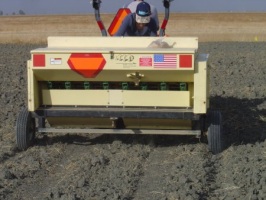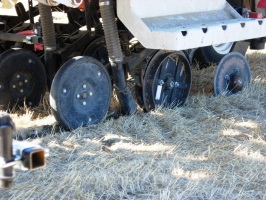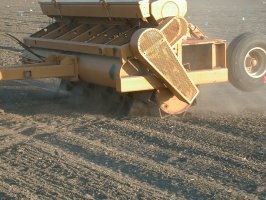THE PLANTING TECHNIQUES TRIAL (Year I)
Emily M. Magill (CSU, Fresno and CSUS/ESRP)
Overview |
|
|
An important objective of the Land Retirement Demonstration Project has been to develop effective re-vegetation strategies that are applicable for large scale restoration, and which incorporate native plant species and existing seeding technologies. As part of this work, the Planting Techniques Trial (Figure 1) was developed to compare different planting methods in a restoration setting. This trial, the Planting Techniques Trial (Year II), and the Native and Invasive Biomass Trial were all a part of my masters research through California State University, Fresno under the primary advisement of Dr. John V.H. Constable. In this field-based trial, comparisons were made among four native plant species (Table 1) that were seeded by three different methods. Seeding methods were: broadcasting (Figure 2), drilling (Figure 3), and imprinting (Figure 4). |
|
|
|
|
|
Imprinting can counteract desertification by transforming smooth, flat, compacted soil into an open system that is ready for water infiltration (Dixon 1990). This transformation is accomplished by creating funnel shaped imprints that act as holding basins for water, increasing seed contact with moisture as each imprint creates a 30 cm2 "micro-watershed" that can hold several liters of rainwater (Dixon & Carr 2000). In previous trials, we have found that even seeding distribution with the imprinter requires almost 30 linear meters. Because plot size in this trial was only 3.7 x 7.3 m (12 ft by 25 ft), we modified the imprinting treatment. Typically, seed from the imprinter hopper falls onto the imprinting drum which creates depressions in the ground and allows the seed to fall into these depressions. For this trial, seed was first broadcast onto the plot and a 'dry' imprinter was run over the plot in order to mimic the effect of imprinting. This treatment was termed 'broadprinting'. Subsequently, the comparability of broadprinting and imprinting was evaluated (see: the Planting Techniques Trial - Year III). The study required 60 plots. Species were chosen based on their halophytic nature, resistance to drought, and success in previous restoration studies. Seed for the study was harvested from the LRDP native plant nursery. Measurements taken in the field included percent cover, seedling count, soil moisture, and gas exchange measurements including photosynthetic rate and stomatal conductance. Because of poor rainfall in 2003-2004 (66% of 30 year mean) and intense weed loads, results were inconclusive and a modified version of this trial was undertaken during 2004-2005. |
|
Table 1. Species collected for use in the Planting Techniques Trial (Year I), including botanical family, common name, and growth form.
| Species | Family | Common Name | Growth form |
|---|---|---|---|
| Atriplex polycarpa | Chenopodiaceae | cattle saltbush | shrub |
| Hemizonia pungens | Asteraceae | common tarweed | annual herb |
| Phacelia ciliata | Hydrophyllaceae | Great Valley Phacelia | annual herb |
| Suaeda moquinii | Chenopodiaceae | seepweed | sub woody perennial |
References
Dixon, R. M. 1990. Land imprinting for dryland revegetation and restoration. pp. 14-22. In: Environmental Restoration: Science and Strategies for Restoring the Earth. Berger, J. J. (ed.). Island Press, Covelo.
Dixon, R. M. and A. B. Carr. 2000. Land imprinting specifications for ecological restoration and sustainable agriculture. Proceedings of the International Erosion Control Association Conference 31. Feb 21-25, 2000. Palm Springs, Ca.
Page created: March 1, 2005; Last updated: April 25, 2005



